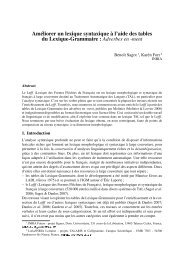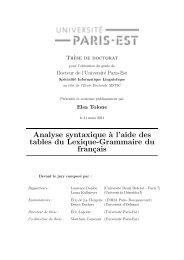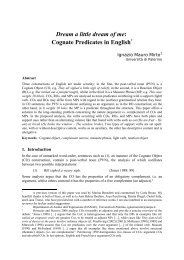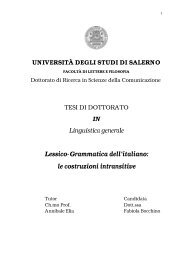Existe-t-il une corrélation entre l'intelligence émotionnelle ... - Accueil
Existe-t-il une corrélation entre l'intelligence émotionnelle ... - Accueil
Existe-t-il une corrélation entre l'intelligence émotionnelle ... - Accueil
Create successful ePaper yourself
Turn your PDF publications into a flip-book with our unique Google optimized e-Paper software.
Ces quatre aptitudes <strong>émotionnelle</strong>s, de la perception jusqu’à la régulation, « sont<br />
présumées de complexité croissante » (Mayer & Salovey, 1997, cités par Roy, 2006).<br />
La première branche se situe à un niveau hiérarchique basique et concerne les processus<br />
psychologiques de base, sur laquelle les autres se construisent ; l’aptitude de régulation<br />
se situe au plus haut de la hiérarchie et concerne les processus les plus complexes.<br />
Chaque branche est ensuite elle-même divisée en quatre sous-aptitudes organisées en<br />
fonction de leur émergence au cours du développement humain (Mayer et al., 2004).<br />
Figure 1 : Le modèle des quatre branches 2<br />
1. Perception, Appraisal and Expression of Emotion<br />
Ab<strong>il</strong>ity to identify<br />
emotion in one's<br />
physical states,<br />
feelings, and<br />
thoughts.<br />
2. Emotional Fac<strong>il</strong>itation of Thinking<br />
Emotions prioritize<br />
thinking by directing<br />
attention to important<br />
information.<br />
Ab<strong>il</strong>ity to identify<br />
emotions in other<br />
people, designs,<br />
artwork, etc. through<br />
language, sound,<br />
appearance, and<br />
behavior.<br />
Emotions are<br />
sufficiently vivid and<br />
ava<strong>il</strong>able that they<br />
can be generated as<br />
aids to judgment<br />
and memory<br />
concerning feelings.<br />
Ab<strong>il</strong>ity to express<br />
emotions accurately,<br />
and to express<br />
needs related to<br />
those feelings.<br />
Emotional mood<br />
swings change the<br />
individual's<br />
perspective from<br />
optimistic to<br />
pessimistic,<br />
encouraging<br />
consideration of<br />
multiple points of<br />
view.<br />
3. Understanding and Analyzing Emotions; Employing Emotional Knowledge<br />
Ab<strong>il</strong>ity to label<br />
emotions and<br />
recognize relations<br />
among the words and<br />
the emotions<br />
themselves, such as<br />
the relation between<br />
liking and loving.<br />
Ab<strong>il</strong>ity to interpret the<br />
meanings that<br />
emotions convey<br />
regarding<br />
relationships, such<br />
as that sadness often<br />
accompanies a loss.<br />
Ab<strong>il</strong>ity to understand<br />
complex feelings:<br />
simultaneous<br />
feelings of love and<br />
hate or blends such<br />
as awe as a<br />
combination of fear<br />
and surprise.<br />
Ab<strong>il</strong>ity to discriminate<br />
between accurate<br />
and inaccurate, or<br />
honest vs. dishonest<br />
expressions of<br />
feeling.<br />
Emotional states<br />
differentially<br />
encourage specific<br />
problem- solving<br />
approaches such as<br />
when happiness<br />
fac<strong>il</strong>itates inductive<br />
reasoning and<br />
creativity.<br />
Ab<strong>il</strong>ity to recognize<br />
likely transitions<br />
among emotions,<br />
such as the<br />
transition from<br />
anger to satisfaction<br />
or from anger to<br />
shame.<br />
4. Reflective Regulation of Emotion to Promote Emotional and Intellectual Growth<br />
Ab<strong>il</strong>ity to stay open<br />
to feelings, both<br />
those that are<br />
pleasant and those<br />
that are unpleasant.<br />
2 http://eqi.org/4bmodel.htm<br />
Ab<strong>il</strong>ity to reflectively<br />
engage or detach<br />
from an emotion<br />
depending upon its<br />
judged<br />
informativeness or<br />
ut<strong>il</strong>ity.<br />
Ab<strong>il</strong>ity to reflectively<br />
monitor emotions in<br />
relation to oneself<br />
and others, such as<br />
recognizing how<br />
clear, typical,<br />
influential or<br />
reasonable they are.<br />
Ab<strong>il</strong>ity to manage<br />
emotion in oneself<br />
and others by<br />
moderating negative<br />
emotions and<br />
enhancing pleasant<br />
ones, without<br />
repressing or<br />
exaggerating<br />
information they may<br />
convey.<br />
12







